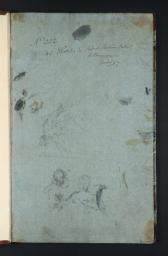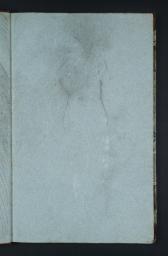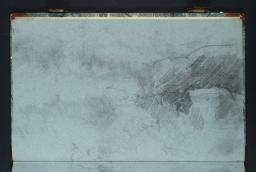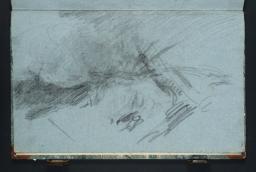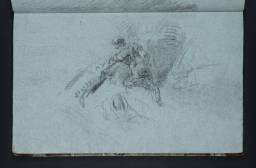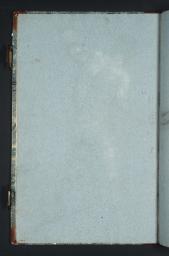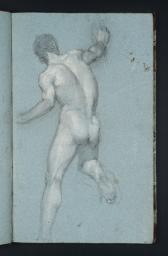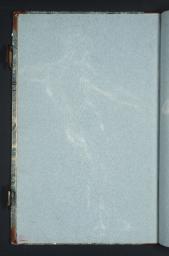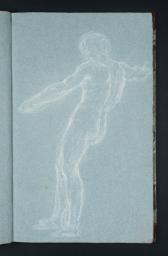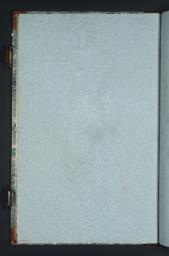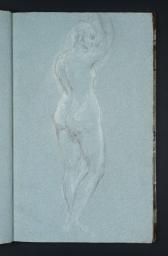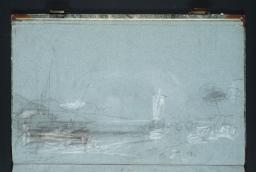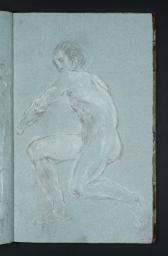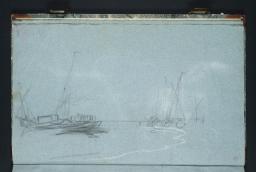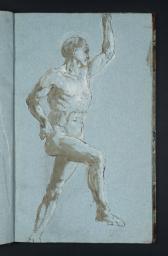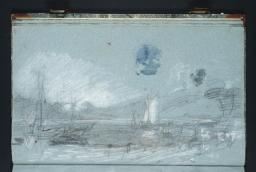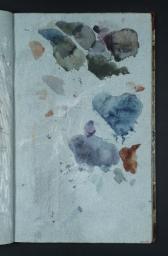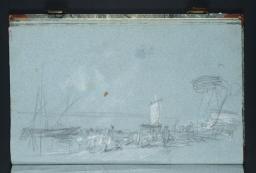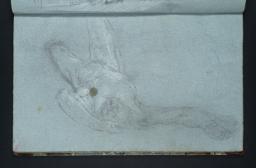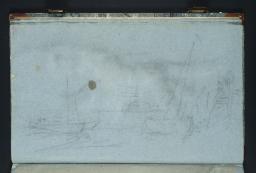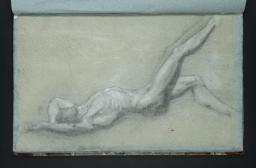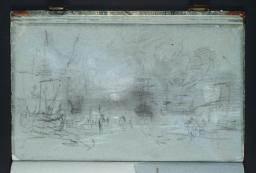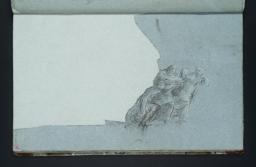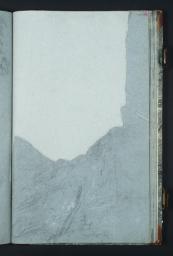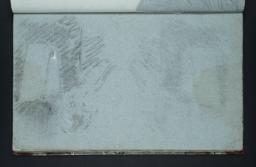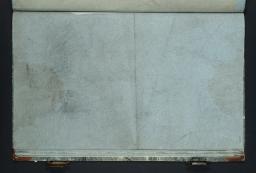Turner Bequest LXXXI 1–170
Sketchbook half–bound in boards covered in marbled paper with calf leather spine (renewed) and corners; two brass clasps
86 leaves of blue laid paper; page size 436 x 271 mm; watermarks ‘1794’, ‘VI’ and Strasburg lily
Numbered 222 as part of the Turner Schedule in 1854, and endorsed by the Executors of the Turner Bequest on folio 1 recto (D04902)
Stamped in black ‘LXXXI’ inside front cover, top left
86 leaves of blue laid paper; page size 436 x 271 mm; watermarks ‘1794’, ‘VI’ and Strasburg lily
Numbered 222 as part of the Turner Schedule in 1854, and endorsed by the Executors of the Turner Bequest on folio 1 recto (D04902)
Stamped in black ‘LXXXI’ inside front cover, top left
Accepted by the nation as part of the Turner Bequest 1856
Exhibition history
References
This sketchbook embodies in exceptionally vivid form the ferment of ideas that characterised Turner’s activity around 1800. He was planning a number of large–scale historical pieces and landscapes to signal his election as Associate and then full member of the Royal Academy, in 1799 and 1802, and maintaining his attendance at the Academy’s Life School in order both to confirm his membership of the institution and to provide himself with figures suitable for inclusion in historical subjects. The scale of the book, larger than any to date, and its blue French paper combined with the medium of chalk, suggest that he was consciously emulating the working methods of the Old Masters whose paintings he sought to rival.
Some of the most important subjects rehearsed here use material that he gathered during his journey to France and Switzerland in the summer and autumn of 1802, and the book is named after the striking drawings recording the artist’s arrival at Calais, ‘nearly Swampt’; see folios 30 verso–31 recto; D04960–D04961; Turner Bequest LXXXI 58–59). Finberg gives the impression that these drawings were made on the spot ‘before the other passengers could land’,1 but it is unlikely that Turner actually took the book with him on that journey. It was reserved for ideas – another ‘Studies for Pictures’ book, in effect; compare the Academical and Studies for Pictures sketchbooks (Tate; Turner Bequest XLIII, LXIX). Drawings of the Calais incident and others derived from his continental tour must have been done from memory.
All the inscriptions in the book, for the most part identifying picture subjects, are in the same pen and black ink, and seem to be annotations added in 1805; the date occurs on folios 44 verso, 48 verso and 50 verso (D04988, D04996, D05000; Turner Bequest LXXXI 86, 94, 98).2 It is reasonable to suppose that Turner made these notes when he had filled up the book and intended to put it aside for future reference; 1805 is therefore the year in which it was probably filled. He went on using the book as a source of ideas for several years afterwards, and possibly as late as the 1830s; see folio 30 recto (D04959; Turner Bequest LXXXI 57).
Drawings associated with finished pictures exhibited and/or sold include studies for the following paintings:
Royal Academy 1801:
Dutch Boats in a Gale: Fishermen Endeavouring to Put their Fish on Board (‘The Bridgewater Seapiece’; private collection, on loan to the National Gallery, London)4
The Army of the Medes Destroyed in the Desart by a Whirlwind – foretold by Jeremiah, chap. xv. ver 32, and 33 (untraced)5
Dutch Boats in a Gale: Fishermen Endeavouring to Put their Fish on Board (‘The Bridgewater Seapiece’; private collection, on loan to the National Gallery, London)4
The Army of the Medes Destroyed in the Desart by a Whirlwind – foretold by Jeremiah, chap. xv. ver 32, and 33 (untraced)5
Turner’s gallery 1807:
Sheerness and the Isle of Sheppey, with the Junction of the Thames and the Medway from the Nore (National Gallery of Art, Washington, DC)18
Sheerness and the Isle of Sheppey, with the Junction of the Thames and the Medway from the Nore (National Gallery of Art, Washington, DC)18
Royal Academy 1807:
Sun Rising through Vapour; Fishermen Cleaning and Selling Fish (National Gallery, London)19
Sun Rising through Vapour; Fishermen Cleaning and Selling Fish (National Gallery, London)19
There are also numerous studies for an important watercolour of about 1805, Lake of Geneva, with Mont Blanc from the Lake (Yale Center for British Art, New Haven).22
Subjects considered but not executed include: the parting of Hero and Leander – eventually the subject of a painting of that title exhibited at the Royal Academy in 1837 (National Gallery, London, on loan to Tate, L01408);23 the death of Adonis; William Tell escaping from the boat; the water turned to blood (the first Plague of Egypt); and views of Edinburgh. These latter were evidently a product of Turner’s Scottish tour of 1801, which did result in some Edinburgh subjects being sent for exhibition; see the Edinburgh sketchbook (Tate; Turner Bequest LV).
Technical notes
How to cite
Andrew Wilton, ‘Calais Pier sketchbook c.1799–1805’, sketchbook, May 2013, revised by Matthew Imms, March 2015, in David Blayney Brown (ed.), J.M.W. Turner: Sketchbooks, Drawings and Watercolours, Tate Research Publication, April 2016, https://www

